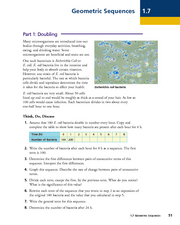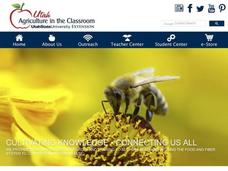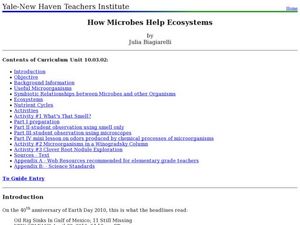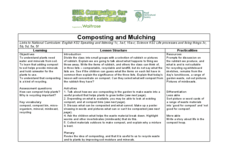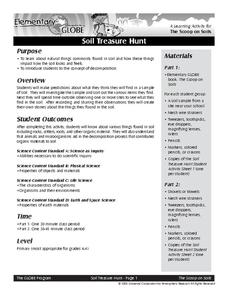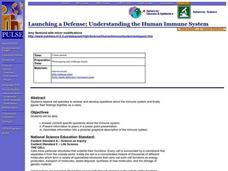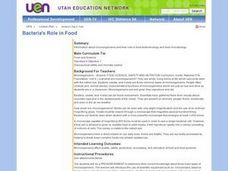Baylor College
Observing Different Microbes
Following directions from a colorful slide preparation card, beginning biologists examine three different live microorganisms: bacteria, yeast, and paramecia. This is not an unusual activity to do with your class, but if you are doing it...
Baylor College
Tools of Magnification
Life science learners need to be able to use a microscope. With this comprehensive resource, they first experience how lenses and magnification work, and then get familiar with using a compound microscope. Tremendous background...
Curated OER
Regents High School Examination: Living Environment 2010
This exam touches upon every topic within the typical first year biology course.. A broad variety of question styles give high schoolers every opportunity to show what they know. Why start from scratch when a comprehensive final exam is...
Curated OER
Geometric Sequences - Bacterial Growth
Bring algebra to life with scientific applications. Math minded individuals calculate and graph the time it takes a bacterium to double. They discuss geometric sequences and use a chart to graph their findings. There are 38...
Curated OER
Microbe Experimentation
Sixth graders formulate a question about microorganisms that can be answered with an experiment. They develop a hypothesis for a questin about microorganisms based on observations and prior knowledge. Pupils carry out an investigation on...
Curated OER
Microscopy
In this microscope worksheet, students complete 15 review questions of labeling, defining and short answer after finishing a compound microscope lab. Lab included.
Curated OER
Chapter 16, Food Biotechnology
Although the points given on these slides are valid, the visual accessibility is poor. Consequently, many viewers would be distracted or entirely unable to view the presentation. The content is a review of microorganisms and their...
Curated OER
The World of Living Things
The World of Living Things is the focus of this biology presentation. Students view a presentation which introduces them to cells, parts of cells, microorganisms, and simple vs. complex animals. They see that they are classified as a...
Curated OER
It's Alive! Using Microorganisms in Cooking
Students create a KWL chart about food. In this chemistry lesson plan, students differentiate physical and chemical changes. They explain how microorganisms are used in food preparation.
Curated OER
How Microbes Help Ecosystems
Sixth graders observe different microorganisms under the microscope. In this biology lesson plan, 6th graders draw and describe the samples they see. They study the root nodules of plants and explain how the plants benefit from those...
Curated OER
Microbial Influence on Earth's Systems
Students identify the different biogeochemical cycles on Earth. For this biology lesson, students observe microbes under a microscope. They compare and contrast respiration and photosynthesis.
Curated OER
Composting and Mulching
Second graders define composting and recognize what can be composted. In this composting and mulching instructional activity, 2nd graders classify objects or pictures as good or bad for composting. Students write a story about life...
Curated OER
Shake It!
Students examine plants and insects. In this plant lesson, students explore their surroundings on a nature walk. Students collect samples of plants and determine the different insects present.
Curated OER
Microbe Experimentation
Sixth graders conduct a microbe experiment. In this microbe lesson, 6th graders develop an experiment with micro-organisms, complete the associated worksheet, and complete a table showing the results.
Curated OER
Hand Washing: I can handle it!
Sixth graders examine microorganisms. In this germs instructional activity, 6th graders observe and record data on the positive and negative aspects of microorganisms. Students complete activities, view a film, and explore...
Curated OER
Predicting the Growth of Microorganisms
Students determine where microorganisms might be found around their school. In this scientific investigation lesson, students collect cultures from various locations and place these in petri dishes. They incubate the cultures to see if...
Curated OER
Soil Treasure Hunt
Students explore the concept of soil and decomposition. In this soil and decomposition lesson plan, students investigate bags of soil. Students then learn how animals and other organisms help in the decomposition process.
Curated OER
Naked to the Eye
Students understand that microorganisms are too small to see but there are other indications they exist. For this microorganisms lesson, students recognize that some microorganism are helpful and some are not. Students use a microscope...
Curated OER
Launching a Defense; Understanding the Human Immune System
Students research online to answer and develop questions about immune system, create Powerpoint presentation to share information with classmates, and assimilate information into pictorial and/or graphical description of immune system.
Curated OER
Launching a Defense; Understanding the Human Immune System
Students research online to answer and develop questions about immune system, create Powerpoint presentation to share information with classmates, and assimilate information into pictorial and/or graphical description of immune system.
Curated OER
Things Living in a Pond
Ninth graders observe, compare, and classify various microorganisms using a microscope. They answer discussion questions, and record their observations on a chart.
Curated OER
Microorganism Multiplication
Sixth graders conduct experiments with yeast to study characteristics of microorganisms. They, working is small groups, change the variables in the experiments and note the results which they later discuss as a class.
Curated OER
Bacteria's Role in Food
Students grow bacteria cultures on agar in petri dishes and do a plate count. They participate in a yogurt making lab to see how bacteria produce lactic acid. They prepare a recipe and identify fungi, fermentation and the role of...
Curated OER
Yeasts and Molds
Students investigate the characteristics and nature of yeast and molds help to explain how these microorganisms affect food production. They experiment with yeast in sourdough in preparing sourdough pancakes.





